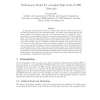Free Online Productivity Tools
i2Speak
i2Symbol
i2OCR
iTex2Img
iWeb2Print
iWeb2Shot
i2Type
iPdf2Split
iPdf2Merge
i2Bopomofo
i2Arabic
i2Style
i2Image
i2PDF
iLatex2Rtf
Sci2ools
GLOBECOM
2006
IEEE
2006
IEEE
Performance Model for a Lossless Edge Node of OBS Networks
In this paper, the performance model for a lossless OBS edge node is built with respect to the queueing performance of the transmission buffer. In contrast to the shaping effect of the burst assembly in the bufferless edge node, in a lossless edge node the “burstifying” effect of the assembly is more dominant and leads to a worse queueing performance in the transmission buffer. We analyze the traffic characteristic by means of the variance process and identify that there exists a negative correlation structure in the assembled burst traffic in the small time scale, which resembles that of a CBR flow. Through the analysis of the relevant time scale, it is found that this small time scale traffic behavior dominates the queueing performance in most cases and the performance of burst transmission buffer can be well estimated by a corresponding ND/D/1 model. In the case of the self-similar input traffic with large peakness and at a high system load, the tail behavior of large qu...
| Added | 11 Jun 2010 |
| Updated | 11 Jun 2010 |
| Type | Conference |
| Year | 2006 |
| Where | GLOBECOM |
| Authors | Guoqiang Hu |
Comments (0)

